1998 GMC SIERRA steering
[x] Cancel search: steeringPage 98 of 452

Engine Coolant Heater (If Equipped)
In very cold weather, 0°F (- 1 SOC) or colder, the engine
coolant heater can help. You’ll get easier starting and
better fuel economy during engine warm-up. Usually,
the coolant heater should be plugged in a minimum of
four hours prior to starting your vehicle.
To Use the Engine Coolant Heater
1. Turn off the engine.
2. Open the hood and unwrap the electrical cord.
The engine coolant heater electrical cord
is located
on the driver’s side
of the engine compartment, near
the power steering reservoir.
3. Plug it into a normal, grounded 110-volt AC outlet.
Plugging the cord into an ungrounded outlet
could cause an electrical shock.
Also, the wrong
kind
of extension cord could overheat and cause
a fire. You could be seriously injured. Plug the
cord into a properly grounded three-prong 110-volt
AC outlet. If the cord won’t reach, use a
heavy-duty three-prong extension cord rated for
at least
15 amps.
4. Before starting the engine, be sure to unplug and store
the cord
as it was before to keep it away from moving
engine parts.
If you don‘t, it could be damaged.
How long should you keep the coolant heater plugged
in? The answer depends on the outside temperature, the
kind of
oil you have, and some other things. Instead of
trying to list everything here, we ask that you contact
your dealer
in the area where you‘ll be parking your
vehicle. The dealer can give
you the best advice for that
particular area.
ProCarManuals.com
Page 118 of 452
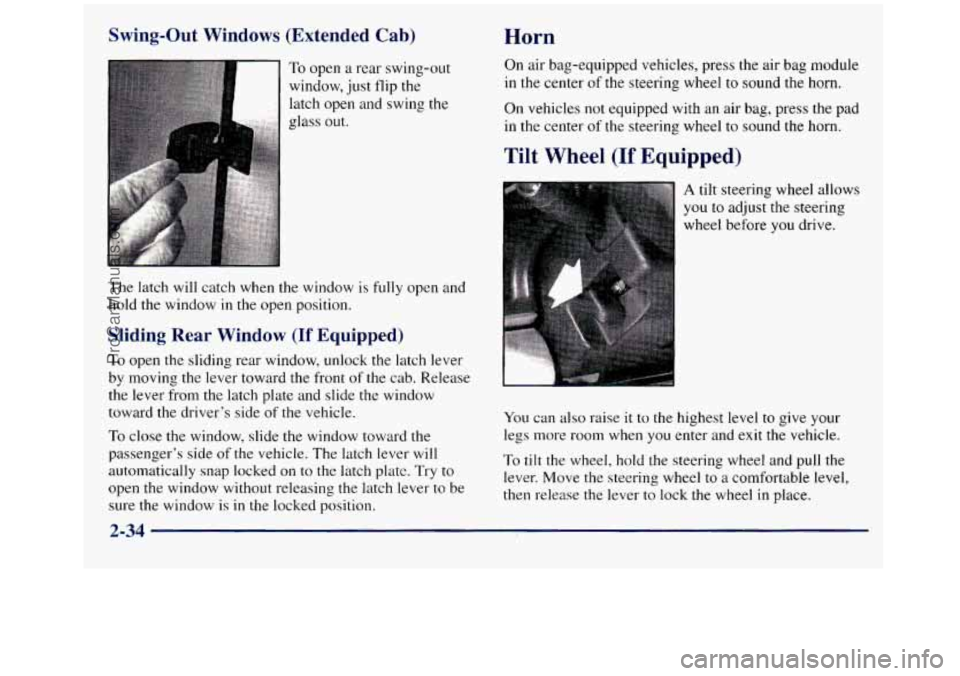
Swing-Out Windows (Extended Cab)
Sliding Rear Window (If Equipped)
To open the sliding rear window, unlock the latch lever
by moving the lever toward the front
of the cab. Release
the lever from the latch plate and slide the window
toward the driver’s side
of the vehicle.
To close the window, slide the window toward the
passenger’s side
of the vehicle. The latch lever will
automatically snap locked on to the latch plate. Try to
open the window without releasing the latch lever to be sure the window is
in the locked position.
Horn
On air bag-equipped vehicles, press the air bag module
in the center
of the steering wheel to sound the horn.
On vehicles not equipped with an air bag, press the pad
in the center of the steering wheel to sound the horn.
Tilt Wheel (If Equipped)
A tilt steering wheel allows
you to adjust the steering
wheel before
you drive.
You can also raise it to the highest level to give your
legs more room when you enter and exit the vehicle.
To tilt the wheel, hold the steering wheel and puli the
lever. Move the steering wheel to
a comfortable level,
then release the lever to lock the wheel
in place.
2-34
ProCarManuals.com
Page 119 of 452
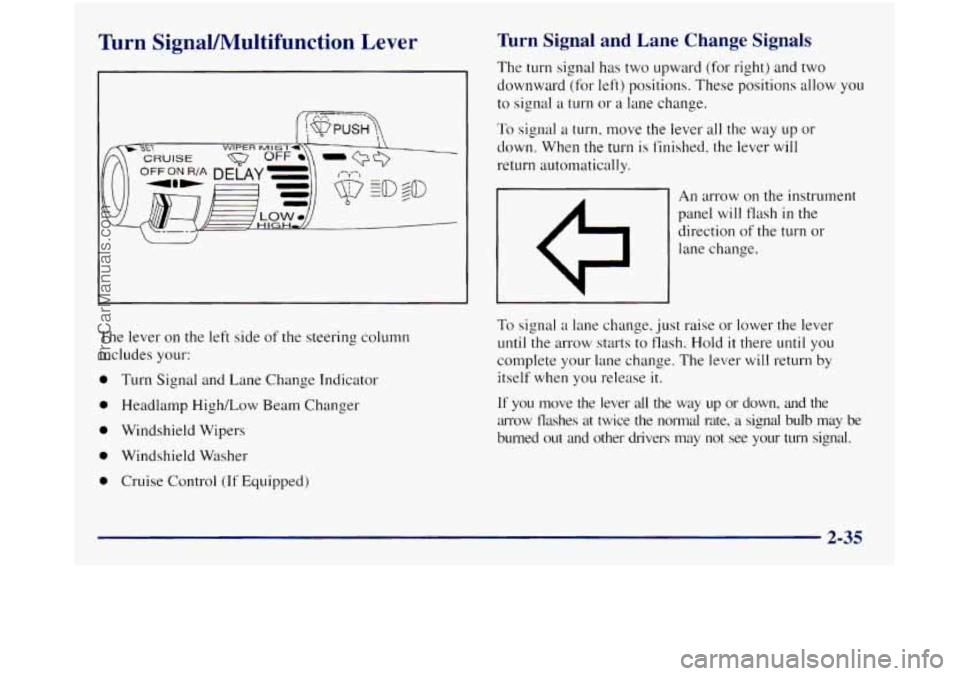
Turn SignaVIWultifunction Lever Turn Signal and Lane Change Signals
The turn signal has two upward (for right) and two
downward (for left) positions. These positions allow you
to signal
a turn or a lane change.
To signal a turn, move the lever all the way up or
down. When
the turn is finished, the lever will
return automatically.
An arrow on the instrument
panel will flash
in the
direction
of the turn or
lane change.
The lever on the left side
of the steering column
includes your:
0 Turn Signal and Lane Change Indicator
0 Headlamp High/Low Beam Changer
0 Windshield Wipers
0 Windshield Washer
0 Cruise Control (If Equipped)
To signal a lane change, just raise or lower the lever
until the arrow starts to flash. Hold it there
until you
complete your lane change. The lever will return by
itself when you release it.
If you move the lever all the way up or down, and the
arrow flashes at twice the normal rate,
a signal bulb may be
burned out and other drivers may not see your
turn signal.
2-35
ProCarManuals.com
Page 189 of 452
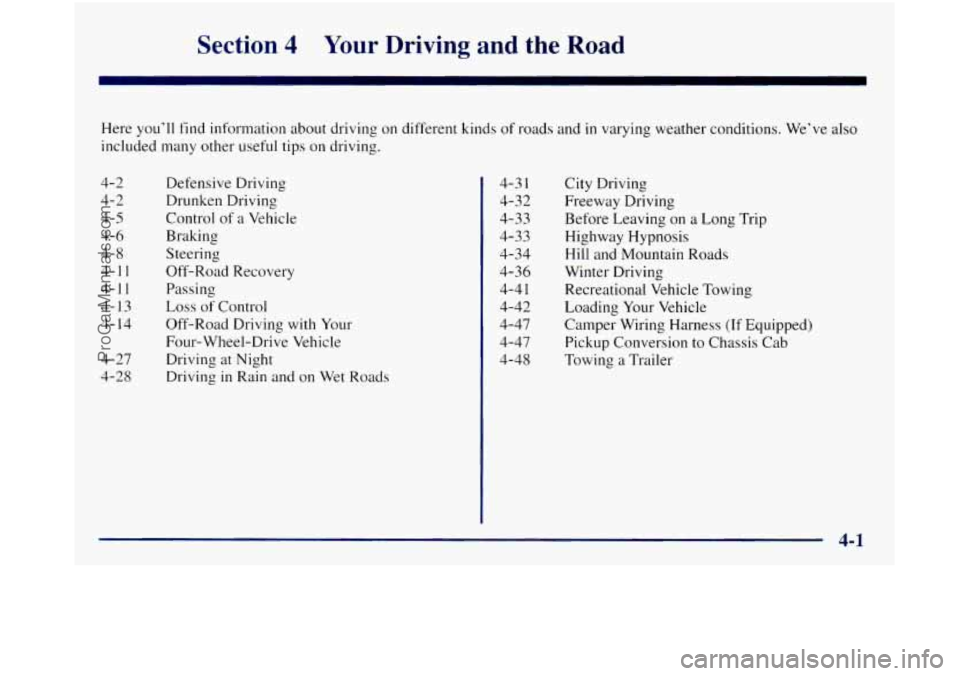
Section 4 Yoiir Driving and the Road
Here you’ll find information about driving on different kinds of roads and in varying weather conditions. We’ve also
included many other useful tips on driving.
4-
2
4- 2
4-5
4-6
4- 8
4-1
1
4-1 1
4- 13
4- 14
4-27
4-28
Defensive Driving Drunken Driving
Control of a Vehicle
Braking
Steering
Off-Road Recovery Passing
Loss of Control
Off-Road Driving with Your
Four-Wheel-Drive Vehicle
Driving at Night
Driving
in Rain and on Wet Roads 4-3
1
4-32
4-33
4-33
4-34
4-36 4-4
1
4-42
4-47
4-47
4-48 City Driving
Freeway Driving
Before Leaving
on a Long Trip
Highway Hypnosis
Hill and Mountain Roads
Winter Driving Recreational Vehicle Towing
Loading Your Vehicle
Camper Wiring Harness
(If Equipped)
Pickup Conversion
to Chassis Cab
Towing a Trailer
4-1
ProCarManuals.com
Page 193 of 452
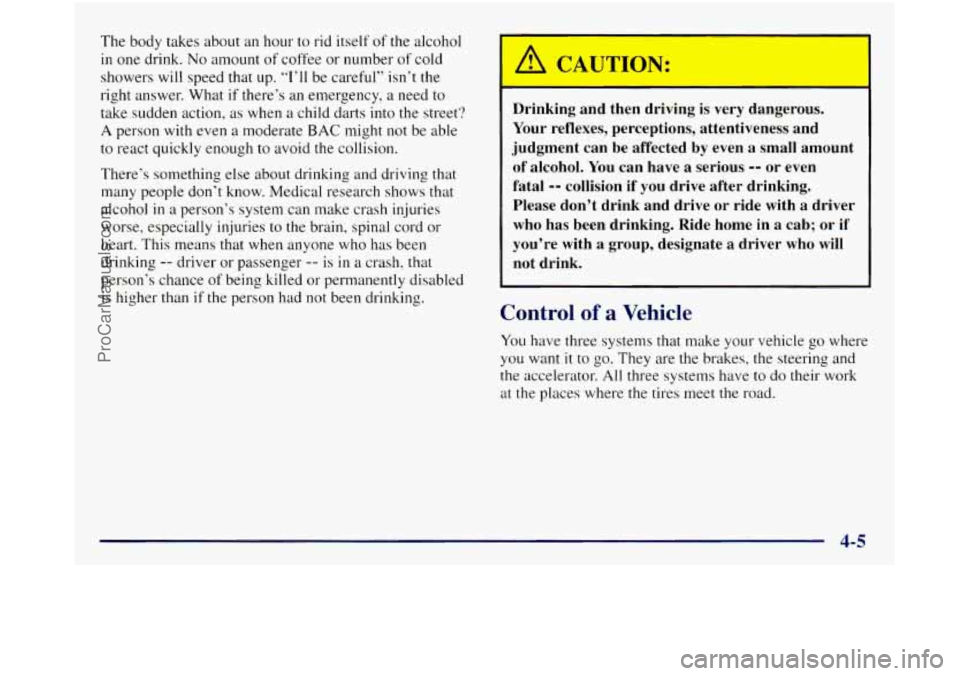
The body takes about an hour to rid itself of the alcohol
in one drink. No amount of coffee or number of cold
showers will speed that up.
“I’ll be careful” isn’t the
right answer. What
if there’s an emergency, a need to
take sudden action, as when a child darts into the street?
A person with even a moderate BAC might not be able
to react quickly enough to avoid the collision.
There‘s something else about drinking and driving that
many people don’t know. Medical research shows that
alcohol
in a person’s system can make crash injuries
worse, especially injuries to the brain, spinal cord or
heart. This means that when anyone who has been
drinking
-- driver or passenger -- is in a crash, that
person’s chance of being killed or permanently disabled
is higher than if the person had not been drinking.
A CAUTION:
Drinking and then driving is very dangerous.
Your reflexes, perceptions, attentiveness and
judgment can be affected by even a small amount
of alcohol. You can have a serious
-- or even
fatal
-- collision if you drive after drinking.
Please don’t drink and drive or ride with
a driver
who has been drinking. Ride home in
a cab; or if
you’re with
a group, designate a driver who will
not drink.
Control of a Vehicle
You have three systems that make your vehicle go where
you want
it to go. They are the brakes, the steering and
the accelerator.
All three systems have to do their work
at the places where the tires meet
the road.
4-5
ProCarManuals.com
Page 196 of 452
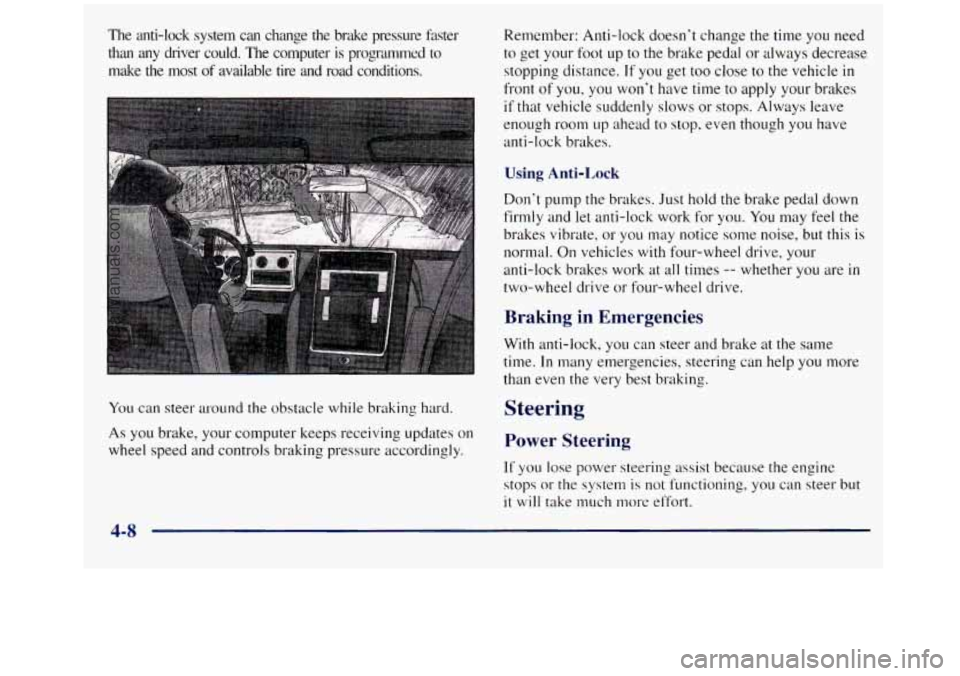
The anti-lock system can change the brlzke pressure faster
than any driver could. The computer is programmed
to
make the most of available tire and road conditions.
You can steer around the obstacle while braking hard.
As you brake, your computer keeps receiving updates on
wheel speed and controls braking pressure accordingly. Remember: Anti-lock doesn’t change the
time you need
to get your foot
up to the brake pedal or always decrease
stopping distance.
If you get too close to the vehicle in
front of you, you won’t have time to apply your brakes
if that vehicle. suddenly slows or stops. Always leave
enough room
up ahead to stop, even though you have
anti-lock brakes.
Using Anti-Lock
Don’t pump the brakes. Just hold the brake pedal down
firmly and let anti-lock work for you.
You may feel the
brakes vibrate, or you may notice some noise, but this is
normal. On vehicles
with four-wheel drive, your
anti-lock brakes work at all times
-- whether you are in
two-wheel drive or four-wheel drive.
Braking in Emergencies
With anti-lock, you can steer and brake at the same
time. In many emergencies, steering can help you more
than even the very best braking.
Steering
Power Steering
If you lose power steering assist because the engine
stops
or the system is not functioning, you can steer but
it will take much more effort.
4-8
ProCarManuals.com
Page 197 of 452
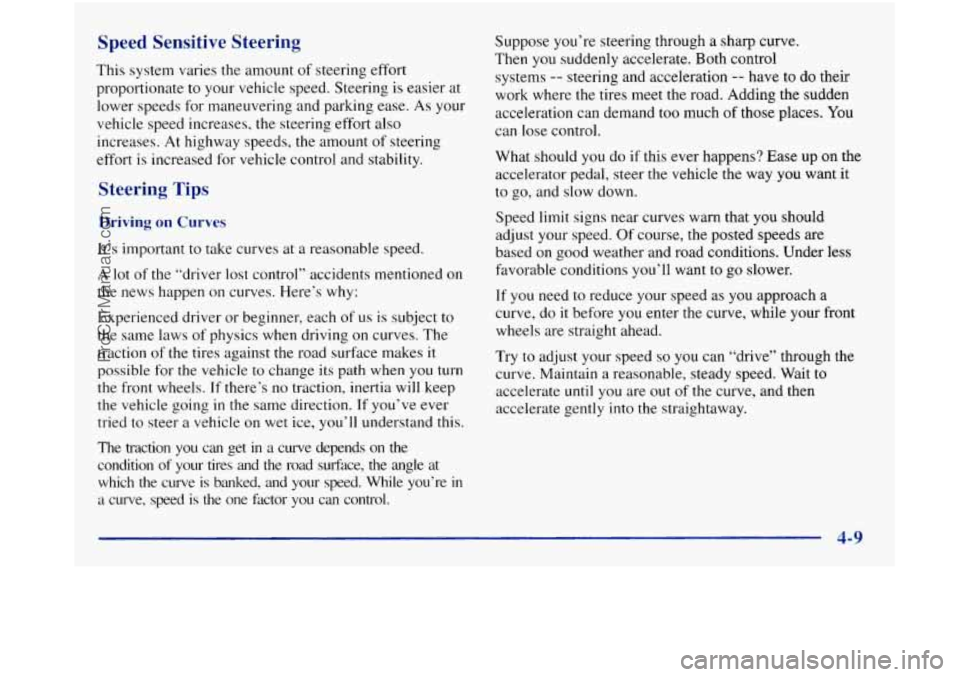
Speed Sensitive Steering
This system varies the amount of steering effort
proportionate
to your vehicle speed. Steering is easier at
lower speeds for maneuvering and parking ease.
As your
vehicle speed increases,
the steering effort also
increases.
At highway speeds, the amount of steering
effort is increased for vehicle control and stability.
Steering Tips
Driving on Curves
It’s important to take curves at a reasonable speed.
A lot of the “driver lost control” accidents mentioned on
the news happen on curves. Here’s why:
Experienced driver or beginner, each
of us is subject to
the same laws of physics when driving on curves. The
traction of the tires against the road surface makes
it
possible for the vehicle to change its path when you turn
the front wheels.
If there’s no traction, inertia will keep
the vehicle going
in the same direction. If you’ve ever
tried
to steer a vehicle on wet ice, you‘ll understand this.
The traction
you can get in a curve depends on the
condition of your tires and the road surface, the angle at which the curve
is banked, and your speed. While you’re in
a curve, speed is the one factor you can control. Suppose you’re
steering through a sharp curve.
Then you suddenly accelerate. Both control
systems
-- steering and acceleration -- have to do their
work where the tires meet the road. Adding the sudden
acceleration can demand too much
of those places. You
can lose control.
What should
you do if this ever happens? Ease up on the
accelerator pedal, steer the vehicle the way
you want it
to go, and slow down.
Speed
limit signs near curves warn that you should
adjust your speed.
Of course, the posted speeds are
based on good weather and road conditions. Under less
favorable conditions you’ll want to go slower.
If you need to reduce your speed as you approach a
curve, do
it before you enter the curve, while your front
wheels are straight ahead.
Try to adjust your speed
so you can “drive” through the
curve. Maintain a reasonable, steady speed. Wait to
accelerate
until you are out of the curve, and then
accelerate gently into the straightaway.
4-9
ProCarManuals.com
Page 198 of 452
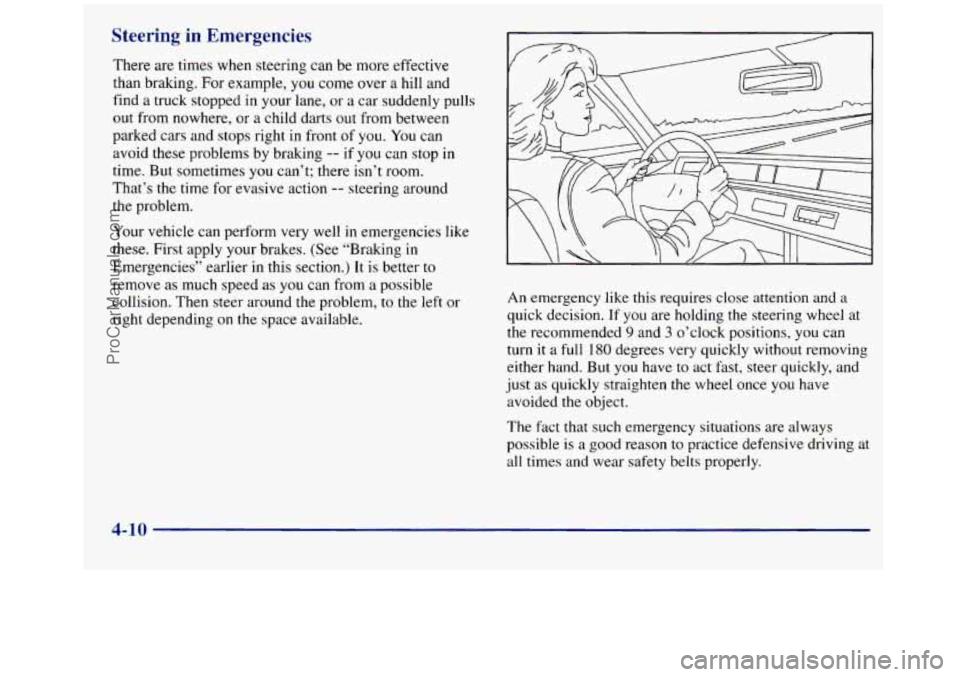
Steering in Emergencies
There are times when steering can be more effective
than braking. For example, you come over a hill and
find a truck stopped in your lane, or
a car suddenly pulls
out from nowhere, or
a child darts out from between
parked cars and stops right in front
of you. You can
avoid these problems by braking
-- if you can stop in
time. But sometimes you can’t; there isn’t room.
That’s
the time for evasive action -- steering around
the problem.
Your vehicle can perform very well
in emergencies like
these. First apply your brakes. (See “Braking in
Emergencies’’ earlier in this section.)
It is better to
remove as much speed as you can from a possible
collision. Then steer around the problem, to the left or
right depending on the space available. An
emergency like this requires close attention
and a
quick decision. If you are holding the steering wheel at
the recommended
9 and 3 o’clock positions, you can
turn it
a full 180 degrees very quickly without removing
either hand. But
you have to act fast, steer quickly, and
just as quickly straighten the wheel once you have
avoided
the object.
The fact that such emergency situations are always
possible is a good reason to practice defensive driving at
all times and wear safety belts properly.
4-10
ProCarManuals.com